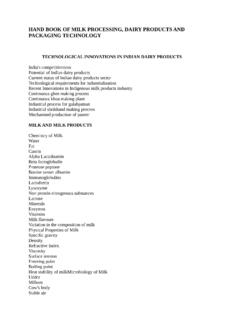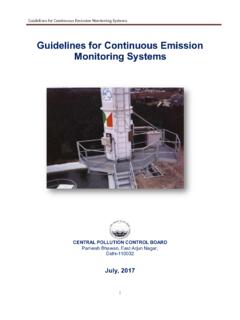Transcription of diyas - NCERT
1 Production of goods in large quantities afterprocessing from raw materials to morevaluable products is called manufacturing. Doyou know that paper is manufactured fromwood, sugar from sugarcane, iron and steelfrom iron ore and aluminium from bauxite?Do you also know that some types of clothesare manufactured from yarn which itself is anindustrial product?People employed in the secondary activitiesmanufacture the primary materials intofinished goods. The workers employed in steelfactories, car, breweries, textile industries,bakeries etc. fall into this category. Some peopleare employed in providing services.
2 In thischapter, we are mainly concerned withmanufacturing industries which fall in thesecondary economic strength of a country ismeasured by the development ofmanufacturing OF MANUFACTURINGM anufacturing sector is considered the backboneof development in general and economicdevelopment in particular mainly because Manufacturing industries not only help inmodernising agriculture, which forms thebackbone of our economy, they also reducethe heavy dependence of people onagricultural income by providing them jobsin secondary and tertiary sectors. Industrial development is a precondition foreradication of unemployment and povertyfrom our country.
3 This was the mainphilosophy behind public sector industriesand joint sector ventures in India. It was alsoaimed at bringing down regional disparitiesby establishing industries in tribal andbackward areas. Export of manufactured goods expandstrade and commerce, and brings in muchneeded foreign exchange. Countries that transform their rawmaterials into a wide variety of furnishedgoods of higher value are s prosperity lies in increasing anddiversifying its manufacturing industries asquickly as and industry are not exclusiveof each other. They move hand in hand. Forinstance, the agro-industries in India have givena major boost to agriculture by raising itsproductivity.
4 They depend on the latter for rawmaterials and sell their products such asirrigation pumps, fertilisers, insecticides,pesticides, plastic and PVC pipes, machines andtools, etc. to the farmers. Thus, development andcompetitiveness of manufacturing industry hasnot only assisted agriculturists in increasingOn the occassion of Diwali, Harish went toa market with his parents. They purchasedshoes and clothes for him. His motherpurchased utensils, sugar , tea and diyas (earthen lamps). Harish observed that theshops in the market were flooded withitems for sale. He wondered how so manyitems could be made in such largequantities.
5 His father explained that shoes,clothes, sugar etc. are manufactured bymachines in large industries, some utensilsare manufactured in small industries, whileitems like diyas are made by individualartisans in household you have some ideas about theseindustries?2015-1666 CONTEMPORARY INDIA IItheir production but also made the productionprocesses very the present day world of globalisation,our industry needs to be more efficient andcompetitive. Self-sufficiency alone is notenough. Our manufactured goods must be atpar in quality with those in the internationalmarket. Only then, will we be able to competein the international of industry to NationalEconomyOver the last two decades, the share ofmanufacturing sector has stagnated at 17 percent of GDP out of a total of 27 per cent forthe industry which includes 10 per cent formining, quarrying, electricity and is much lower in comparison to someEast Asian economies, where it is 25 to 35 percent.
6 The trend of growth rate in manufacturingover the last decade has been around 7 percent per annum. The desired growth rate overthe next decade is 12 per cent. Since 2003,manufacturing is once again growing at therate of 9 to 10 per cent per annum. Withappropriate policy interventions by thegovernment and renewed efforts by theindustry to improve productivity, economistspredict that manufacturing can achieve itstarget over the next decade. The NationalManufacturing Competitiveness Council(NMCC) has been set up with this LocationIndustrial locations are complex in are influenced by availability of rawmaterial, labour, capital, power and market,etc.
7 It is rarely possible to find all these factorsavailable at one place. Consequently,manufacturing activity tends to locate at themost appropriate place where all the factors ofindustrial location are either available or canbe arranged at lower cost. After an industrialactivity starts, urbanisation follows. Sometimes,industries are located in or near the , industrialisation and urbanisation gohand in hand. Cities provide markets and alsoprovide services such as banking, insurance,transport, labour, consultants and financialadvice, etc. to the industry . Many industriestend to come together to make use of theadvantages offered by the urban centres knownas agglomeration economies.
8 Gradually, alarge industrial agglomeration takes the pre-Independence period, mostmanufacturing units were located in placesfrom the point of view of overseas trade such asMumbai, Kolkata, Chennai, etc. Consequently,there emerged certain pockets of industriallydeveloped urban centres surrounded by a hugeagricultural rural Market LinkageThe key to decision of the factory locationis the least cost. Government policies andspecialised labour also influence the locationof INDUSTRIESC lassification of IndustriesList the various manufactured products youuse in your daily life such as transistors,electric bulbs, vegetable oil, cement,glassware, petrol, matches, scooters,automobiles, medicines and so on.
9 If weclassify the various industries based on aparticular criterion then we would beable to understand their manufacturingbetter. Industries may be classified asfollows:On the basis of source of raw materialsused: Agro based: cotton, woollen, jute, silktextile, rubber and sugar , tea, coffee,edible oil. Mineral based: iron and steel, cement,aluminium, machine tools, to their main role: Basic or key industries which supply theirproducts or raw materials to manufactureother goods iron and steel and coppersmelting, aluminum smelting.
10 Consumer industries that produce goodsfor direct use by consumers sugar ,toothpaste, paper, sewing machines,fans the basis of capital investment: A small scale industry is defined withreference to the maximum investmentallowed on the assets of a unit. This limithas changed over a period of time. Atpresent the maximum investment allowedis rupees one the basis of ownership: Public sector, owned and operated bygovernment agencies BHEL, SAIL etc. Private sector industries owned andoperated by individuals or a group ofindividuals TISCO, Bajaj Auto Ltd.












